Two Useful, But Different .30-Caliber Options
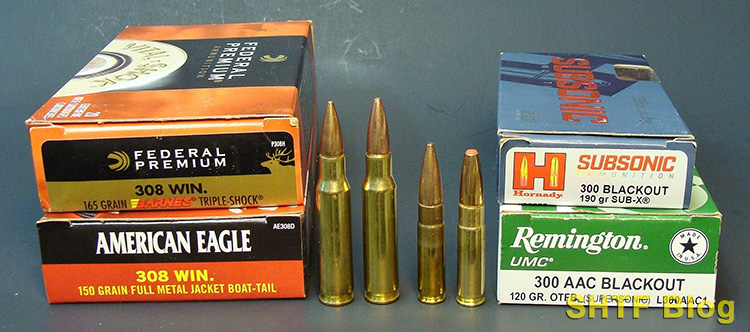
I dropped by a local gun store the other day and noticed an intriguing pistol-length AR-15 behind the counter. The tag listed it as a .300 Blackout and, knowing my son was in the market for one, I asked to take a look. This prompted a comment from an older woods-wise customer whose take was, the .300 Blackout was pretty much a wasted effort because a .308 could produce better results with any bullets of the same diameter.
This brings us to the next big caliber debate – .300 Blackout vs .308 Winchester. These comparisons never die, and it’s why we’ve covered similar topics before: 9mm vs .40 and .30-30 vs .308 to name a few.
.300 Blackout vs .308 Winchester – The Big Debate
This man’s opinion was grounded in some logic. The .308 can indeed fire them all at much higher velocities. But where do we draw the line? The .30/06 will best a .308. The .300 Winchester Magnum will trounce ‘em all, as will the lengthy list of other .30-magnums.
But increased performance comes with costs beyond expense, to include recoil and overall size. Somewhere, there’s a happy balance. The .308 hits the sweet spot nicely, and it offers sufficient power to handle most high-power rifle chores.
Born for the U.S. M-14 service rifle, it’s also a perfect match for compact sporting guns. However, as time marched on, a few shortcomings appeared – none of which were a direct fault of the excellent .308 Winchester. The somewhat convoluted path that revealed them led to today’s .300 Blackout.
First up was adoption of the U.S. M-16; a much lighter successor to the M-14 that fired a smaller .223/5.56 NATO cartridge. Explosive growth of the civilian AR-15 followed, leading to increasing interest in more potent calibers. No luck with the .308 though. Despite attempts to cram the cartridge into a platform smaller than the AR-10, it’s is just too large for an AR-15.
Sometime later a huge spike in suppressor interest developed – with a wrinkle directly related to the AR platform: If fired in an AR-10, the .308 is difficult to silence to its fullest extent, while maintaining reliable function. You can spin a suppressor on the muzzle of any threaded .308 muzzle, but it’ll generate a nasty crack with standard supersonic rounds.
Watered-down subsonic loads are one solution, but the capacious .308 case doesn’t play well with small powder charges – which also lack the pressures needed to cycle autoloaders. Not that the .308 Winchester isn’t an extremely useful cartridge; it most certainly is! The only real fly in the ointment is the hush factor.
.308 Winchester
I covered the .308 in a comparison to the .223 Remington/.5.56 NATO. What follows is the crux of the .308 content from that article.
The .308 is based on a shortened ’06 case. It was developed for use in machineguns and the M-14 Rifle (a post-war evolution of the classic M-1 Garand). Being especially suitable for semi and full-auto systems, the new .30-caliber T-65 cartridge soon gained favor among other Cold War allies, culminating in its 1954 designation of 7.62 NATO. But, Winchester recognized its sporting potential even earlier and introduced the new .308 Winchester to civilians in 1952.
Both cartridges are almost identical, but military chambers are cut with a bit of extra clearance (headspace) to promote reliable feeding in machineguns, etc. Military rounds may also have thicker brass – a greater concern for handloaders.
Nevertheless, I once fired a bunch of de-linked 7.62 machinegun rounds through my agency-issue Remington 26” HB M-700. Accuracy, although not sub-MOA, was good enough to ring steel silhouettes beyond a quarter-mile.
When finalized, the military T-65 fired a 147-grain bullet at around 2800 feet per second (fps), close to the ’06 thanks to more efficient propellants. Of course, heavier bullets and/or shorter barrels will decrease this velocity. The M-14 had a 22-inch barrel. My chronograph indicates muzzle velocities closer to 2600 fps with several 168-grain loads fired through 20-inch barrels.
The old ’06 will best most .308 loads (particularly those with heavier bullets), but the latter is still plenty capable. As a result of its popularity much effort has gone into civilian loads. To a lesser extent, the military also followed suit.
In a real sense, the .308 is a breakthrough cartridge. Its case was quickly reformed to create a series of other new calibers from .243 Winchester to .358 Winchester, along with several in between. Rifle manufacturers like Sako and Remington began offering “short-action” versions of their bolt-guns with compact receivers.
These stiffer actions, if fitted with good barrels, can deliver outstanding accuracy. The .308’s moderate propellant charges decrease recoil and also limit throat erosion. Most .308 barrels incorporate a 1:12 rifling-twist, which seems to stabilize a number of bullets weighing from 110- 180 grains.
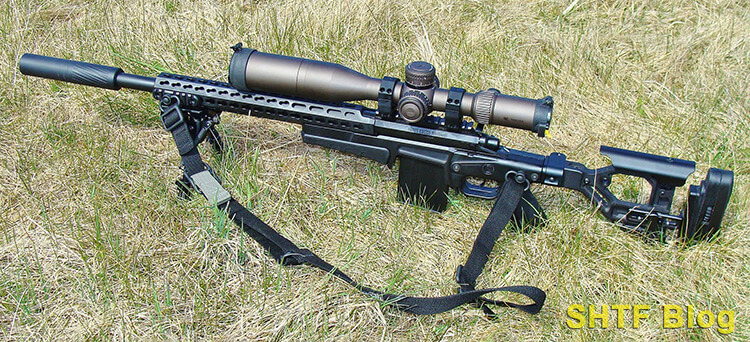
However, growing interest in long-range shooting has led to sleek but heavier projectiles of 190 grains or more. Thus, some barrels now use slightly quicker rates such as 1:10.
Long-Range Use
The recent precision-rifle mania has led to targets set at great distances, and one result has been a series of new flat-shooting cartridges. Of note though, the .308 is still offered in a number of the heavy-barrel bolt-action models designed for these events.
Long-range shooting is a topic all it’s own, but the short story is, the .308 still has reach thanks to today’s rangefinders, ballistic apps, and trajectory-compensating scopes. Even in a basic sporting rifle, the .308 should be more than adequate for most of us – certainly good out to a quarter-mile. You could double that with the right equipment – and necessary skills.
General-Purpose Use
The popularity of the .308 ensures a great assortment of useful hunting loads. The lightweight 110-grain loads are best for varmints, although some are used for defensive purposes. Affordable soft-points like Remington’s 150-grain Core-Lokts, etc., are fine for whitetail deer. Some hunters in my state also use ‘em for moose, although they may choose 180-grain versions to gain more penetration.
Another option for large North American game is a premium load with a bullet like the time-tested Nosler Partition, or the more recent “monolithics.” The latter types, like the Barnes TS-X or Hornady GMX, employ solid-copper bullets. Because they combine reliable expansion with deep penetration (and near 100% weight retention), the 165-grain offerings can equal or exceed the performance of most conventional 180-grain bullets while generating less recoil.
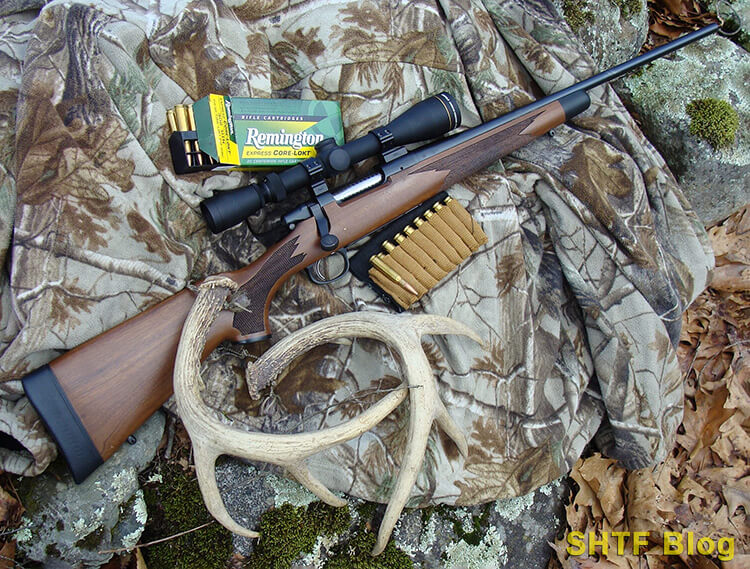
A possible downside of the .308 for some could be recoil. Compared to a number of other effective cartridges it’s not excessive, but its kick will be noticeable. If bothersome, reduced-recoil .308 loads are available with enough power for deer, etc.
Those who own AR-10s tend to send more rounds downrange and the more affordable load for targets (not hunting) is a basic FMJ in a weight similar to the expanding choice. With a bit of luck the same zero may be possible.
Speaking of zeroes, if a full-powered 165-grain .308 load is zeroed at 200 yards, it’ll strike around 2-inches high at 100 yards, and 9-inches low at 300 yards – depending on the length of the barrel. I enjoy ringing steel silhouettes at much further distances with a 20-inch heavy-barreled Remington .308 Model 700.
Its threaded muzzle will accept a suppressor, which eliminates much of the boom common to high-power rifle cartridges. The “can” also reduces recoil – but the sharp supersonic crack is still obvious. For truly quiet shooting the fix is a switch to a different system – chambered for the Blackout.
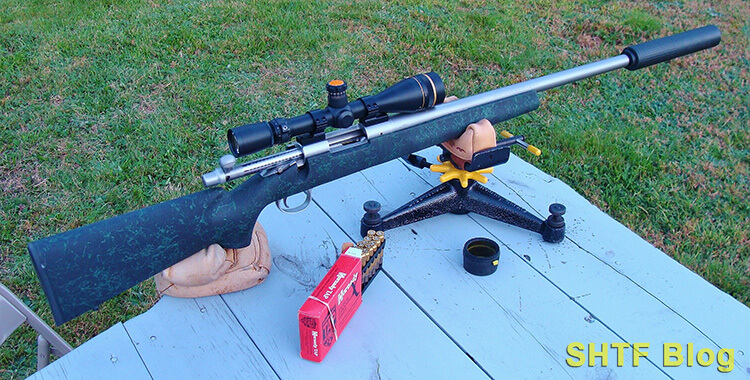
.300 Blackout
I discussed the .300 BLK during a post titled .30-Caliber AR-15 Options. Some of the following is from that article.
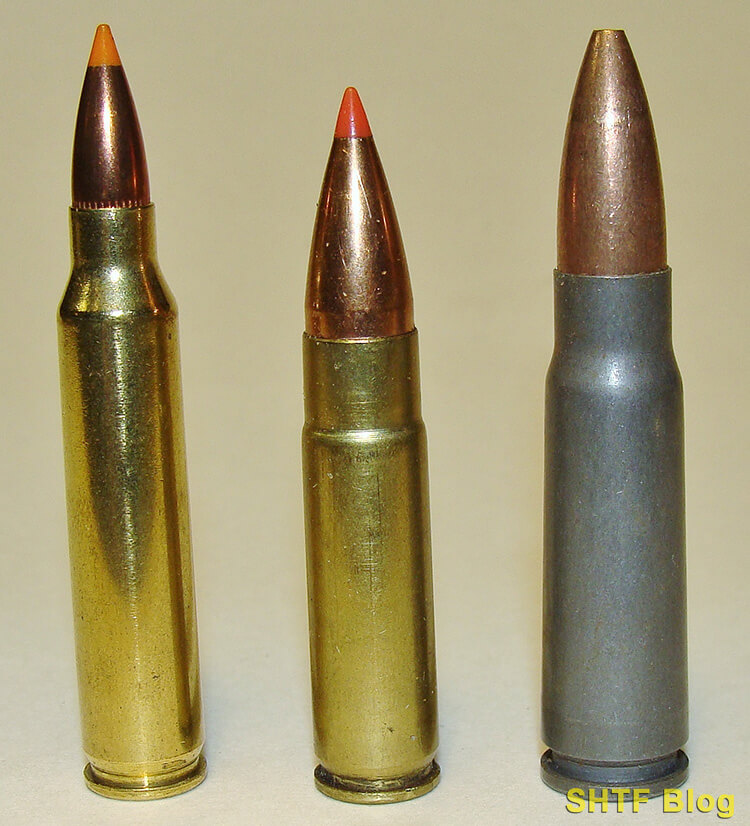
The .300 Blackout cartridge is an evolution of the older J.D. Jones-designed Whisper. You can form brass from 5.56mm/.223 cases by trimming off the shoulder area, but it’s really a necked up .221 Fireball (with an alternate title of 7.62 x 35mm). I’ve written an entire article on converting 5.56 brass to .300.
The original idea, as marketed by SSK, was to offer a .30 cartridge capable of cycling an AR-15. But not just any cartridge! The shortened case left room for longer heavy bullets weighing 200 grains or more.
When fired at subsonic velocity, pressure was sufficient to cycle an AR-15. The cartridges were also short enough to work in standard magazines. The addition of a suppressor resulted in a very quiet rifle; hence the “whisper” moniker. AAC embraced this concept for use by the Spec Ops community, with additional emphasis on fast loads.
After minor tweaks they introduced the new .300 Blackout which, with lighter 110-125 grain loads, increases velocity to around 2300 fps. Recoil is negligible, and performance is roughly on par with the 7.62×39 Russian, using a standard AR bolt-face.
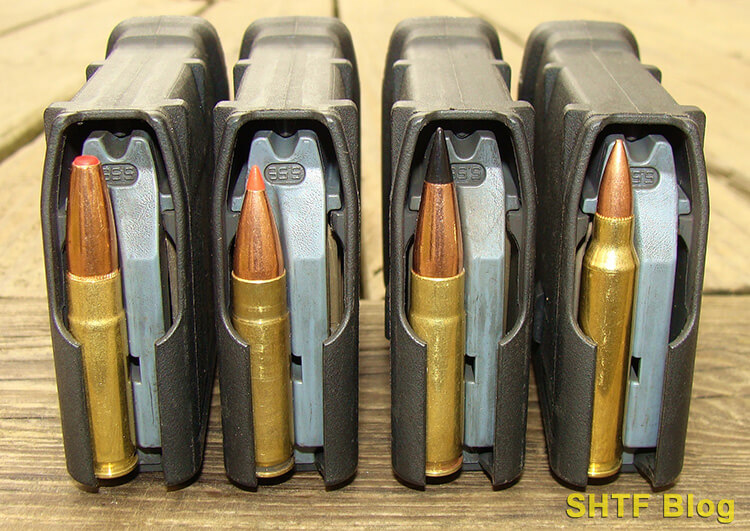
One challenge, given Blackout’s large spread of bullet weights, is a suitable rifling twist. Heavy and/or longer bullets in a given caliber require faster twists. The lightest suitable subsonic bullets are around 190-grains – still downright heavy for any .30-caliber. And 220s aren’t uncommon.
To impart the stability necessary for useful accuracy, most .300 Blk barrels are rifled with fast 1:7, or 1:8 twists. These rates are a bit too quick for peak accuracy with light supersonics of 110-125 grains – the price paid for compromise rates. The good news: Useful bullet choices will still be plenty accurate for most purposes. Expect five-shot groups of less than 1 ½-inches (1.5 MOA) at 100 yards with subs or supersonics. The bigger hurdle is their disparate points of impact (POIs).
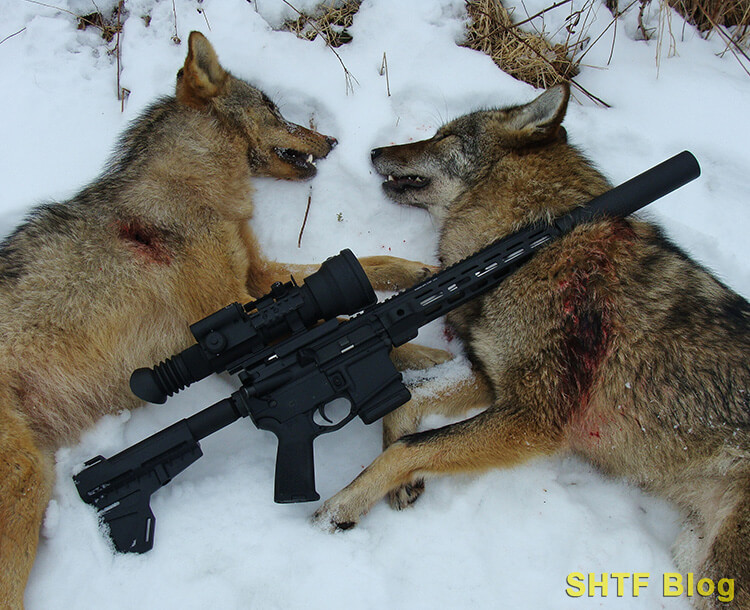
Subsonics
Maximum effectiveness of a silencer is only possible when bullets exit below the speed of sound. Because temperature introduces variables, sonic cracks are best avoided through muzzle velocities below 1100 fps. This raises concerns about expansion when using ultra-heavy bullets necessary for reliable AR-15 function.
I achieved good accuracy and function with Hornady 220-grain round-nose JSP handloads, but they’re really designed for .30/06 velocities. The introduction of Hornady’s Subsonic 190-grain expanding SUB-X load was a welcome game changer – quite literally.
This 1050 fps factory load has quietly accounted for a number of bobcats and large eastern coyotes, all shot within 125 yards – the maximum practical limit for varmints due to the brick-like trajectories of all subs (see my article on coyote hunting). From a 16-inch barrel, if zeroed at 100 yards, SUB-X strikes about 2 ½ inches high at 50 yards, and 3 ½” low at 125 yards.
Supersonics
These loads can wring out the Blackout’s full potential regarding trajectory and terminal effects. The downside is their supersonic crack – which may be a non-issue. For those that add suppressors, supersonics will sound similar to high-speed .22 LRs (from a rifle) – more tolerable than a bare muzzle. As for load preferences, some Blk afficionados shoot bullets as heavy as 150-grains (or more) which, based strictly on accuracy, make sense in quick rifling twists.
To flatten trajectory and improve expansion, I’ve settled on a few lighter 110 – 120-grain bullets capable of accuracy near one-MOA. Hornady’s polymer-tipped 110 V-MAX will hammer (and exit) large coyotes. This bullet may work for average-sized whitetails, but I’d rather play it safe with a tougher monolithic (solid-copper). The several people in my hunting circle have shot enough deer to gain confidence in Barnes polymer-tipped 110 and 120-grain solid-copper TAC-TX bullets (all unrecovered pass-throughs).
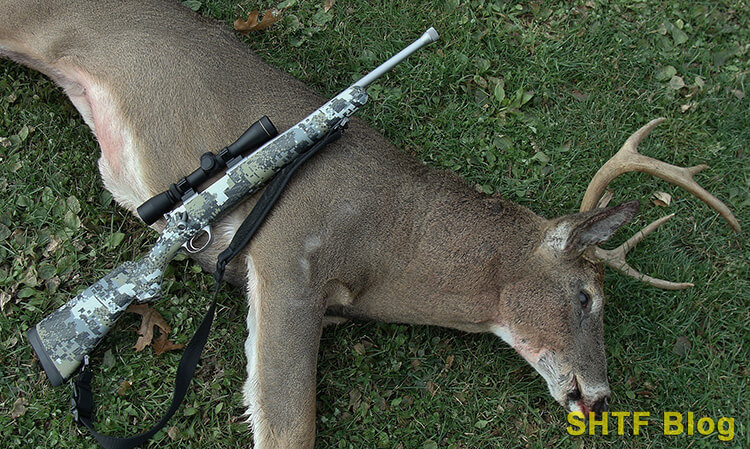
Either of the above 110-grain bullets can be driven to 2350 fps from a 16-inch barrel. If zeroed 2-inches high at 100 yards, they’ll impact that amount low at 200 yards – as far as I’d care to use this cartridge for humane results. My 110s are all handloads, but my son shoots their factory equivalents (using Barnes 120-grain TAC-TX for deer). To gain handier rifles most of these loads are fired through bare muzzles.
Impact Notes
If zeroed per above using supersonics, subsonic .300 Blk loads can strike around a foot low at 100 yards! Forget guesstimation. The better solution is a scope with repeatable adjustments and/or a .300 Blk-specific reticle. Another option: Gather your own data on a range while using a more generic design.
Short Barrels
Because the .300 Blk doesn’t burn much powder, it’s much more efficient than a caliber like the 5.56 NATO. Through my suppressed 10 ½-inch AR-15 pistol, Hornady’s 190 SUB-X manages to clock 1025 fps; darned close to its advertised velocity. Accuracy is also close to one-MOA, which comes as a relief.
My 220-grain subsonic handload key-holed terribly at 100 yards, raising concerns over baffle strikes. Conclusion: The 1:8 twist wasn’t fast enough to stabilize the heavy bullet in that pistol-length barrel. Fortunately, Hornady recommends that rate for their SUB-X load.
More Blackout Bennies
The .300 BLK caught on because it fills unique niches. Beyond its ability to digest quiet subsonics in AR-15s, muzzle blast and recoil with supersonics is no more than a .223. Thus, it’s a good choice for new or smaller shooters in a number of firearms to include single-shot rifles and bolt-actions. The additional .30-caliber punch is also reassuring. The consequence of these positives has been the appearance of numerous firearms and useful .300 Blk loads from mainstream manufacturers.
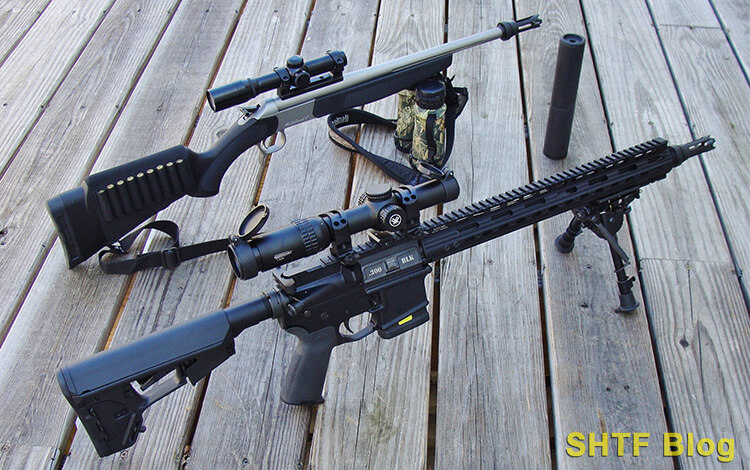
Additional options include AR-15 upper-receiver assemblies and separate barrels. For those who like to tinker, a conversion to .300 Blk requires nothing more than a new barrel. With proper head-spacing, everything else should be good to go. For the most part, this includes magazines.
If using hi-cap types, their internal vertical ribs can squeeze larger stacks of stubby rounds inward through bullet contact. Some users file down their polymer ribs, while others switch to new .300 BLK mags. Or, for greater versatility, just pop the two pins on your AR-15’s lower receiver and drop in another pre-zeroed upper receiver assembly! You’ll have an instant transformer capable of firing .223/5.56 or .300 BLK rounds.
One caution though: To avoid caliber mix-ups, consider distinctive mags and labeled dust-covers!
Extending this strategy further, with a bucket full of 5.56 brass and the correct reloading equipment, a nearly indefinite supply of economical fodder would be assured for either caliber. An entire .300 BLK cartridge-case is shorter than the straight-walled section of a .223/5.56 casing – but both share the same .378” case-head and body. I just saw off the necks of fired 5.56 cases and form my own .300 Blk brass by running them through a resizing die.
Despite these potentially useful advantages, the .300 Blackout isn’t (dare I say it?) a magic bullet.
Which One Should You Choose?
As for the customer in the gun shop, like many other hunters who roam our woods with lever-guns and bolt-actions, these so-called “shortcomings” are of no concern. This fellow will be well served by the same Winchester Model 88 .308 lever-action that’s filled his freezer for the past five decades. But, time marches on others have different concerns.
What if circumstances called for only one rifle? Well, assuming both defense and subsistence hunting were requirements, geographics might dictate the choice. If possible, I’d fudge it and go with a 5.56 AR-15, while slipping in a spare upper receiver chambered for .300 Blackout.
As noted above, we’ve killed a bunch of deer with this caliber. Swapping uppers is as easy as popping the receiver pins, and both calibers are widely distributed. Then again, our terrain is heavily forested. Ranges are short and our biggest carnivores are black bears.
Western hunting is a different matter. Open terrain and large game call for more power and range, so the nod goes to a .308. If dangerous bears are a possibility, even that caliber is sketchy. Get a bigger gun, or cross your fingers and spring for heavy monolithic loads.
Of course, some of us suffer the consequences of obsessive firearms interests. Those into blowing large piles of cash could wind up with rifles in each of these calibers. Of some consolation, if their muzzles happen to have 5/8×24 threads, attachment of QD adapters will permit the use of one .30-caliber suppressor.

4 comments
You can hand load the 308 to do anything the blackout will do. Ant proper should be prepared to hand load and the 308 will be a lot easier to find. My preferred do anything is the Henry long ranger. Flat, light and bolt accuracy with a handy lever action. I have no plan or expectation of going to war so a good .357 revolver and a 12 gage double round out a game getter self defense armory. These type arms have a history of over a century of reliable performance, literally in use every day for decades.
You did a lot of great research! Congrats! There will always be a difference of opinion when it comes to the preference of firearms and ammo. Really depends on your wants,needs and cash flow. I own a 308 bolt action with a Nikon scope. Works great for me. Hog hunts in Florida. You mentioned if SHTF and you were short on ammo. First you would look at ammo availability. Most popular 30-06 then 308 then 30-30 then 300. Pick your poison! I also have a 38 +P police special revolver. Smooth and very accurate.
Stay safe and God Bless…
I have a tendency to prefer military guns and ammo. Picatinny Arsenal spends millions analyzing and studying weapons for the Army. That means I prefer the NATO 308. The 308 shoots accurately at much greater ranges than the 5.56. (I’m an old Artilleryman and like to engage bad guys at ranges they can’t match.) As long as we have some Army left, 308 will be around, making its availability more certain if SHTF. Even if the military goes to 6.5 Creedmoor, it will take years to make the changeover. 308 is the winner in my book.
I’m an old retired fella that enjoys handloading, tinkering and a good article. As I read your article, I’d have to say, you are a great writer.
I’ve enjoyed many calibers through the years, really loved .308. Never had much desire to go to much larger or more powerful calibers.
Recently I started tinkering with 5.56/.223 which I was impressed with its flat trajectory and honestly, I scoffed at the tiny bullet.
Once I had experienced the round and read up on its history, I grew to respect it. It certainly has its place and I won’t go into any lengthy debates surrounding the pros or cons of that mean little round.
Being a .30 caliber enthusiast, I’d heard about the .300 Blackout, had plenty of once-fired .223 brass, the wheels started turning.
After setting up my lathe and getting what I wanted there, I formed my shoulders with the .300 Black sizing die, then loaded up some starting rounds.
The 10.5 inch barrel with a 1:8 twist surprised me. I like sub moa groups as I got from my .308 and did not think a .300 Black could pull it off, again I was wrong. I was shooting .125″ groups at 50 yards and .250″ to .500″ groups at 100 yards. I shot those groups with my .308, 20 inch barrel and was surprised to see that was possible with such a short barreled .300 Blackout.
After this experience with the .300 BLK, I’m sold on it and plan to stick with it. I know it’s not for everyone, there will always be an argument for every caliber out there. But if it works, then go for it.
Thank you for a fine article, I greatly enjoyed it. God bless you and yours.